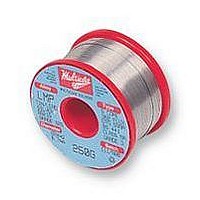HEMPSTEAD, HERTFORDSHIRE HP2 4RQ, UK, TEL. +44 1442 233 233, FAX +44 1442 269 554
THE TECHNICAL INFORMATION CONTAINED HEREIN ARE INTENDED AS REFERENCE
ROSIN BASED CORED SOLDER WIRE FLUXES
Properties of Multicore 362 and 366 solid fluxes for cored
solder wire:
•
•
•
•
•
•
PRODUCT RANGE
Multicore 362 and 366 cored wires are manufactured with a
range of flux contents. Although users will normally be using
products with a nominal flux content of 3%.
Multicore 362 and 366 cored wires are available in a variety of
alloys conforming to J-STD-006 and EN 29453 or alloys
conforming to similar national or international standards. For
details refer to document “Properties of Alloys used in Cored
Solder Wires”. A wide range of wire diameters is available.
Alternative flux contents and alloys may be manufactured to
special order.
TECHNICAL SPECIFICATION
A full description of test methods and detailed test results are
available on request.
Alloys: The alloys used for Multicore flux cored solder wires
conform to the purity requirements of the common national and
international standards. A wide range of wire diameters is
available manufactured to close dimensional tolerances. For
details refer to document “Properties of Alloys used in Cored
Solder Wires ”.
Flux: Multicore 362 and 366 solid flux leave dry and non-sticky
residues. In use its odour is typically that of rosin fluxes.
Test
Acid value
Halide content
SIR Test
(without cleaning)
J-STD-004
Classification
J-STD-004
EN29451-1
HENKEL LOCTITE ADHESIVES LTD. , KELSEY HOUSE, WOODLANE END. HEMEL
ONLY: PLEASE CONTACT HENKEL TECHNOLOGIES FOR ASSISTANCE AND
Good wetting on most common surfaces
Two activity levels: Multicore 362 for general work and
Multicore 366 for more difficult surfaces
Non-corrosive
Fast soldering
Rosin based
Halide activated
RECOMMENDATIONS ON SPECIFICATIONS FOR THIS
TYPICAL FLUX PROPERTIES
Pass
362
170mgKOH/g
<0.5%
ROL1
1.1.2
NOT FOR PRODUCT SPECIFICATIONS
366
158mgKOH/g
1.0%
Pass
ROM1
1.1.2
Multicore
SPECIAL PROPERTIES
Surface Insulation Resistance: Multicore 362 and 366 flux
pass the J-STD-004 SIR test and other elements of J-STD-
004 test protocols associated with the flux classification ROL1
for 362 and ROM1 for 366.
Electromigration Test: Multicore 362 and 366 pass the
Bellcore GR-78-CORE Electromigration tes
RECOMMENDED OPERATING CONDITIONS
Soldering iron: Good results should be obtained using a
range of tip temperatures. However, the optimum tip
temperature and heat capacity required for a hand soldering
process is a function of both soldering iron design and the
nature of the task and care should be exercised to avoid
unnecessarily high tip temperatures for excessive times. A
high tip temperature will increase any tendency to flux spitting
and it may produce some residue darkening.
The soldering iron tip should be properly tinned and this may
be achieved using Multicore cored wire. Severely
contaminated soldering iron tips should first be cleaned and
pre-tinned using Multicore Tip Tinner/Cleaner TTC1, then
wiped on a clean, damp sponge before re-tinning with
Multicore cored wire.
Soldering process: Multicore cored wires contain a careful
balance of resins and activators to provide clear residues,
maximum activity and high residue reliability, without cleaning
in most situations. To achieve the best results from Multicore
solder wires, recommended working practices for hand
soldering should be observed as follows:
• Apply the soldering iron tip to the work surface, ensuring
• Apply Multicore flux cored solder wire to a part of the joint
• Remove solder wire from the work piece and then remove
The total process will be very rapid, depending upon thermal
mass, tip temperature and configuration and the solderability
of the surfaces to be joined.
that it simultaneously contacts the base material and the
cmponent termination to heat both surfaces adequately.
This process should only take a fraction of a second.
surface away from the soldering iron and allow to flow
sufficiently to form a sound joint fillet – this should be
virtually instantaneous. Do not apply excessive solder or
heat to the joint as this may result in dull, gritty fillets and
excessive or darkened flux residues.
the iron tip.
Solder Cored Wire Flux
Technical Data Sheet
362 & 366
June 2004



